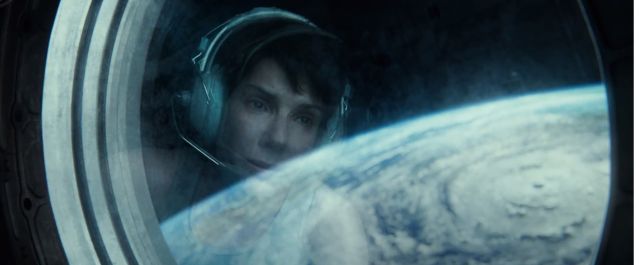Environment
Gravity: Developmental Themes in Space
Sandra Bullock (Ryan Stone) is reborn in Alfonso Cuarón's spectacular film
Posted October 22, 2013

Sandra Bullock as Ryan Stone © Warner Bros. Source: gravitymovie.warnerbros.com
(*Spoiler Alert: This article includes plot details from the film.)
Watching Gravity as a professor who teaches child psychology, I could not help but see the developmental themes that resonate with this spectacular film.
One of the luminous images that lingered with me long after the film ended is the scene in which Ryan Stone (Sandra Bullock) is nestled in the safety of a spacecraft following a grueling battle for her life. She knows this battle is not yet over. In her serenely weightless and suspended state, she slowly retracts her limbs into a resting position that brings to mind the image of a fetus in utero. Here the director waits for a sustained pause, a fermata.
Later, when she is sitting at the controls of the Soyuz space capsule after a period of intense solitude, Ryan is overjoyed to hear the sound of a human voice transmitted over the speaker. She is instantly drawn to the playful, melodious voice. We are exposed to human voices long before birth. The maternal voice - and voices of people speaking close to the mother (at a conversational level of 60 dB) - travel through the intrauterine environment to the fetus' ear, which is already fully functional about three months before birth.
The language is not one that Ryan understands. Nevertheless, she is transfixed by the voice transmitted over the speaker, the one tether to the world she knows. Just like a young infant who is completely engrossed in speech sounds directed to her, Ryan is mesmerized by all that is musical about a voice (prosody) - its melody, rhythm, tempo, phrasing, pauses - without comprehending its content (semantics).
Arbitary connections between sound and assigned meanings defy her. The first sound she attaches to is the howling of a dog in the background of the grainy audio, which she begins to repeat, just as an infant imitates animal sounds and noises with ease. Soothed, she resigns herself to a peaceful and (possibly final) sleep to the sound of what she surmises to be a lullaby, sung by the voice to a young infant.
From what I can recall from a single viewing (and readers are invited to confirm this) the lullaby is sung on repeated pitches that are about a fifth apart. Later, Ryan hums the same interval softly (almost inaudibly) as she prepares the capsule for its final descent to earth. Based on the laws of physics, the interval of a fifth is one of the purest and most consonant intervals that can be produced by two musical tones. Studies show that even as infants, we are drawn to the simple beauty of octaves and perfect fifths. Pythagoras referred to this kind of perfect consonance as ‘the music of the spheres’, ultimately giving Kepler insight into the movement of the planets.

Source: gravitymovie.warnerbros.com
At the end of the film, Ryan escapes the space capsule after it has landed in water and has started to sink, and prepares to swim to the surface. A frog is seen swimming by with long strokes. I am reminded of creatures that are better adapted to live in changing conditions than we are. The amphibious frog begins life as a tadpole with gills but takes in oxygen through both lungs and skin as it develops into a mature frog; it can stay submerged for long periods or even hibernate underwater. The human being also begins life in a liquid environment and does not need lungs for survival in the womb. Yet the lungs must be fully functional when deployed at birth. From that moment on, we will be entirely dependent on the ebb and flow of air to our lungs to live.
Ryan finally breaks the surface of the water for her first gasp of air. We are reminded that human life cannot thrive in the vast emptiness of space nor in the depths of the ocean - but only in the narrow margin, the small interval between sea and sky.
The last scene shows Ryan finally reaching the shores of a beach, lying face down at the water’s edge. Living in a weightless environment has taken a toll on her muscles. Like the young infant passing through early motor milestones, she musters up enough strength to raise her head for a moment before her chin meets mud again. Gradually she raises her head up higher, her shoulders, and then her chest. Like the typical infant, whose upper body is many times stronger than the lower limbs, Ryan draws herself up to a crawling posture mainly by the strengths of her arms - legs collapsing beneath her until they are finally engaged. At last, Ryan is seen standing upright and taking her first steps on the beach, her stiff ankles giving her the stagger of an unsteady toddler. And in the developmental progression of a single human being echoes the achievements of an entire species.
© 2014 Siu-Lan Tan Ph.D
co-author of Psychology of Music: From Sound to Significance (Psychology Press 2010, 2013) and co-editor of The Psychology of Music in Multimedia (Oxford University Press 2013).
Related Posts
A child psychologist's take on a (viral) video:
http://www.psychologytoday.com/blog/what-shapes-film/201311/why-does-ba…
Developmental origins of our attraction to faces:
http://www.psychologytoday.com/blog/what-shapes-film/201311/3-reasons-w…
Notes
A version of this post by Siu-Lan Tan also appears on the Oxford University Blog, entitled Gravity: Developmental Themes in the Alfonso Cuarón Film.


